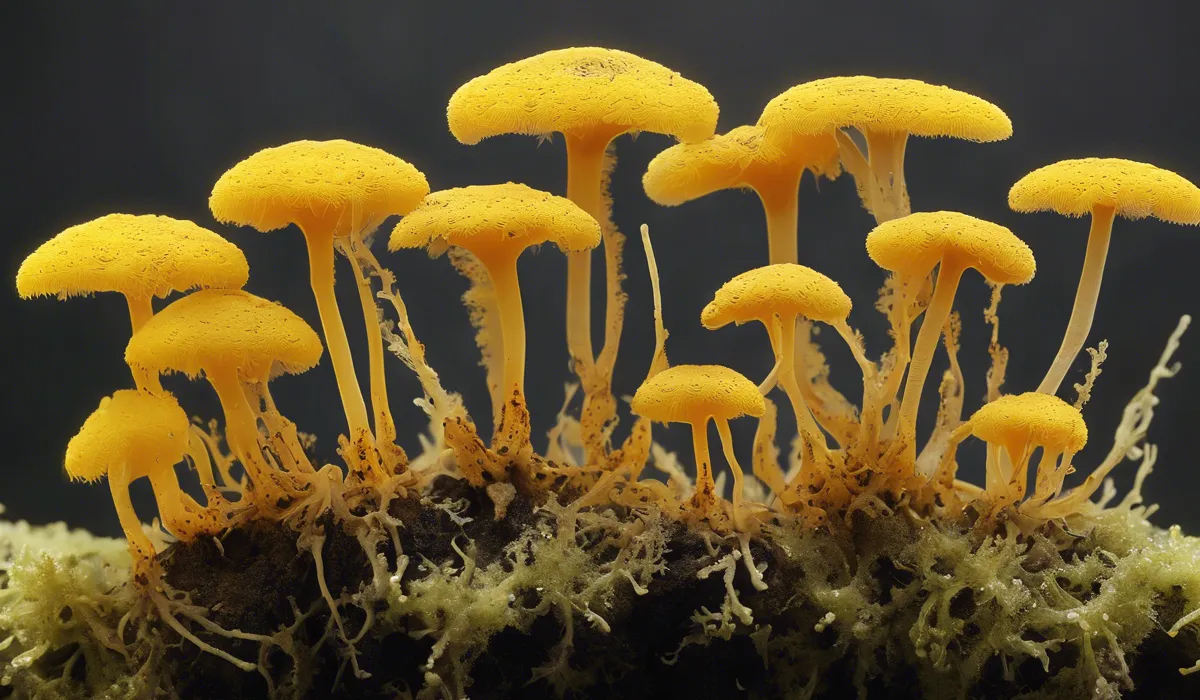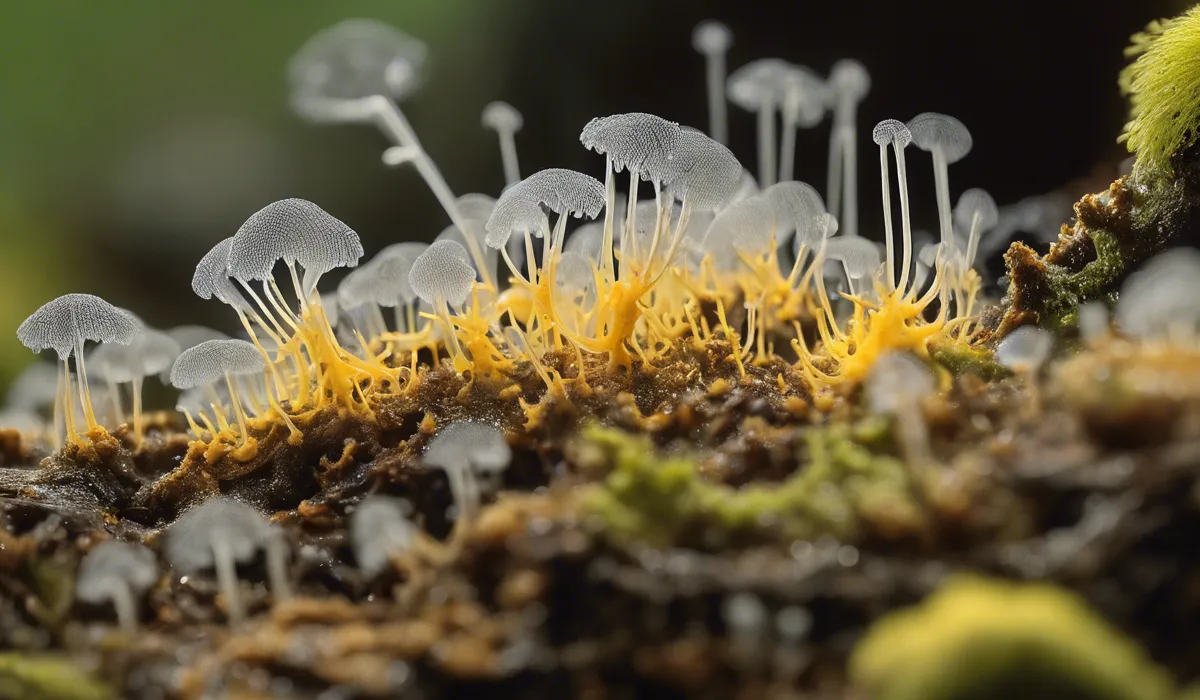Slime molds reproduce by releasing spores from fruiting bodies when food sources are scarce. These spores form new slime molds upon finding suitable conditions. Some slime molds also reproduce asexually through fragmentation.
Reproduction Cycle of Slime Mold

Overview of the Slime Mold Lifecycle
The life of a slime mold begins inconspicuously as a single spore. When conditions are favorable, this spore germinates, giving rise to a slime mold organism.
The mold then feeds and grows, and when it encounters adverse conditions or exhausts its food supply, it starts the remarkable process of reproduction.
This cycle ensures the survival and proliferation of the slime mold across various environments.
Asexual Reproduction Process
Spore Formation
Slime molds predominantly reproduce asexually by producing spores. These spores are formed within specialized structures called fruiting bodies.
When a slime mold’s environment lacks nutrients, it will form these fruiting bodies as a survival mechanism to propagate its genes.
Spore Dispersal Mechanisms
Once spores are produced, they must reach new locations to grow. This dispersal can happen through wind, water, or even animals.
Spores are incredibly resilient and can survive harsh conditions during transit, ensuring that they can take root in new, more favorable environments.
Germination and the Role of Environmental Conditions
Upon reaching a suitable substrate, spores germinate, given the right environmental conditions such as moisture and temperature.
Germination leads to the growth of new slime mold cells, which will feed, multiply, and eventually enter the reproductive phase once more when conditions dictate.
Transition to the Sexual Phase
Triggering Factors for Sexual Reproduction
Slime molds can also reproduce sexually, a process usually triggered by extreme environmental pressures that make asexual reproduction less viable, such as a severe lack of food or drastic changes in the environment.
Formation of Gametes
In the sexual reproduction phase, slime molds produce gametes. These are specialized cells that can fuse with others to create a new organism with a genetic mix from two parents, increasing the genetic diversity of the population.
Gamete Fusion and Zygote Development
When two compatible gametes meet, they fuse to form a zygote. This zygote then develops into a new slime mold, which will grow and eventually reproduce, continuing the cycle.
Sexual reproduction allows slime molds to adapt to changing environments by creating genetically diverse offspring.
Types of Slime Mold and Their Reproductive Strategies

Plasmodial Slime Molds
Describing the Plasmodium Stage
Plasmodial slime molds exist as a large, single cell with multiple nuclei, known as a plasmodium.
This mass of protoplasm is undivided by cell walls, allowing it to move and feed through phagocytosis, engulfing organic particles and bacteria in the soil or on decomposing plants.
How the Plasmodium Forms Spores?
When it is time to reproduce, the plasmodium undergoes a transformation to create a fruiting body.
Within this structure, the protoplasm differentiates into spores, which will eventually be released into the environment to find new habitats.
The Role of the Sclerotium in Adverse Conditions
If the environment becomes too harsh before reproduction can occur, the plasmodial slime mold can form a sclerotium, a dormant form that allows it to survive until conditions improve.
Upon the return of favorable conditions, the sclerotium can reactivate and continue the life cycle.
Cellular Slime Molds
Aggregation of Individual Cells
Unlike plasmodial slime molds, cellular slime molds spend most of their life as single, independent cells. When food is scarce, these cells come together to form a multicellular aggregate.
Formation of the Slug (Pseudoplasmodium)
This aggregate then differentiates into a mobile slug-like structure called a pseudoplasmodium. The slug can move as a single entity to a location suitable for fruiting.
Culmination in Fruiting Body and Spore Production
The slug transforms into a fruiting body, which will then produce spores. These spores are released to begin a new life cycle, dispersing to new areas to germinate into individual cells once more.
Differences in Reproduction between the Two Groups
While both types of slime molds produce spores, their reproductive strategies differ significantly.
Plasmodial slime molds form spores from a multinucleate mass, while cellular slime molds rely on the cooperation of individual cells to form a multicellular reproductive structure.
Factors Influencing Slime Mold Reproduction

Environmental Influences on Reproduction
Temperature
Temperature plays a critical role in the life cycle of slime molds. Most species require a specific temperature range for optimal growth and reproduction, with extreme temperatures inhibiting these processes.
Humidity
Humidity affects the moisture level in the environment, which is crucial for spore germination and the overall health of the slime mold.
Adequate humidity is necessary for the slimy texture of the mold, which facilitates movement and feeding.
Availability of Food
Slime molds need a steady supply of bacteria and organic material to thrive. When food is plentiful, slime molds grow and reproduce.
Conversely, a lack of food resources often triggers the reproductive phase to ensure survival through spore dispersal.
Genetic and Cellular Factors
Genetic Diversity among Slime Molds
Genetic diversity is a crucial factor in the adaptability and resilience of slime molds.
Sexual reproduction introduces genetic variation, which can lead to more robust populations capable of surviving a broader range of environmental conditions.
Role of Cell Signaling in the Reproductive Process
Cell signaling is vital for coordinating the complex behaviors of slime molds, especially in cellular types where individual cells must aggregate to reproduce.
Signaling molecules ensure that cells can find each other and synchronize their actions.
Human Impact on Slime Mold Reproduction
Effects of Pollution and Habitat Destruction
Human activities such as pollution and habitat destruction can have detrimental effects on slime mold populations.
Pollutants can directly harm these organisms or disrupt their food sources, while habitat destruction can limit their available living spaces.
Conservation Efforts and Their Importance for Slime Mold Diversity
Conservation efforts are essential to protect the diverse and often overlooked world of slime molds.
By preserving their habitats and minimizing pollution, we can ensure that slime molds continue to play their critical role in the ecosystem as decomposers and contributors to soil health.
FAQs About Slime Mold Reproduction
How do slime molds reproduce when food is scarce?
Slime molds reproduce by releasing spores from fruiting bodies when food sources are scarce, which can form new slime molds under suitable conditions.
What triggers slime molds to release spores?
The release of spores by slime molds is triggered by a lack of food, prompting them to enter a reproductive phase.
Can slime molds reproduce asexually?
Yes, some slime molds can reproduce asexually through a process known as fragmentation, where a portion of the slime mold develops into a new organism.
What conditions are needed for slime mold spores to form new slime molds?
Slime mold spores require suitable environmental conditions, such as adequate moisture and a food source, to germinate and form new slime molds.
How do the new slime molds form from spores?
New slime molds form from spores when the spores encounter conditions conducive to growth, such as moisture and nutrients, allowing them to germinate and develop into mature slime molds.
Final Thoughts
Slime molds have adapted to reproduce by releasing spores from their fruiting bodies under nutritional stress, ensuring their lineage persists in new, favorable environments.
Additionally, some species can also replicate asexually through fragmentation, a process where parts of the organism break off and develop into independent slime molds.
